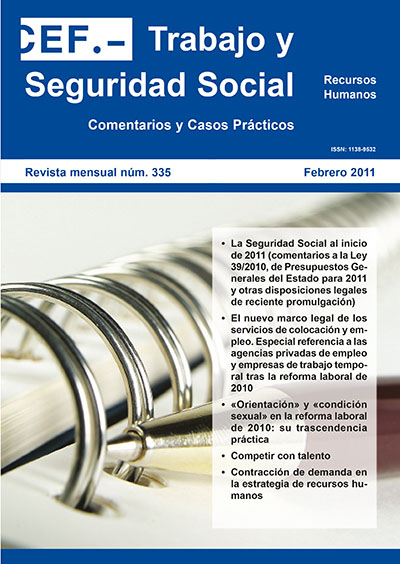Efectos de la contracción de demanda sobre la estrategia de recursos humanos en empresas intensivas en conocimiento
DOI:
https://doi.org/10.51302/rtss.2011.5205Palabras clave:
planificación de recursos humanos, simulación, dinámica de sistemas, gestión del talento, capital intelectual, dirección estratégicaResumen
Este análisis pretende dar respuesta a la necesidad planteada por las empresas de servicios profesionales de servirse de un instrumento que les permita mantener un capital intelectual crítico, base de su ventaja competitiva, aun durante periodos de contracción de la demanda de proyectos. Utilizando un modelo de simulación dinámica que refleja la evolución del flujo de profesionales entre las categorías «junior sin experiencia» y «senior» en empresas de consultoría, se han analizado posibles repercusiones a corto y largo plazo de una contracción de la demanda de servicios profesionales sobre la estrategia de recursos humanos, y se han planteado políticas que pueden atenuar el efecto del cambio de escenario de demanda sectorial sobre este tipo de organizaciones.
En este estudio se plantearon dos objetivos principales: a) el análisis del efecto que podría tener una contracción de la demanda de consultores sobre el flujo de profesionales en este tipo de organizaciones, y b) la evaluación de las consecuencias de un cambio de políticas de recursos humanos sobre el flujo de profesionales y el atractivo de la empresa en el sector de la consultoría.
Los resultados obtenidos indicaron que la aplicación de políticas encaminadas a disminuir el nivel relativo de inversión en formación reducía la capacidad de la empresa para crecer en el futuro. Por ello, se ha podido concluir que la contracción de la demanda no debería ser una razón de peso que justifique un cambio de estrategia de la política de desarrollo profesional de estas empresas. Sin embargo, ante escenarios que implicaban un cambio de ciclo de la demanda, el esperar un tiempo antes de interiorizar los nuevos requerimientos del mercado podría mejorar el ajuste del flujo de profesionales a los demandados a corto plazo, mejorando la competitividad de la organización respecto a competidores que reaccionen de inmediato ante los requerimientos del mercado.
El análisis realizado permitió valorar el uso de la metodología de la dinámica de sistemas como un instrumento de apoyo a la toma de decisiones directiva en el ámbito de la dirección estratégica de los recursos humanos.
Descargas
Citas
Argyris, Ch. [1999]: On Organizational Learning. Blackwell Publishers, Inc.
– [1991] «Teaching smart people how to learn». Harvard Business Review on Knowledge Management, May-June: 81-108.
Asociación Española de Empresas de Consultoría (AEC): La consultoría en España. El sector en cifras (1999-2009).
– The Shared Services and Business Process Outsourcing Association (SBPOA, 2005). HR Transformation Survey (june-october 2005).
Bontis, N.; Chong Keow, W. Ch. y Richardson, S. [2000]: «Intellectual capital and business performance in Malaysian industries». Journal of Intellectual Capital, 1 (1): 85-100.
Boxall, P. [2006]: «The strategic HRM debate and the resource-based view of the firm». Human Resource Management Journal, 6 (3), 59-75.
Cabrera, E.F. y Cabrera, A. [2005]: «Fostering knowledge sharing through people management practices». International Journal of Human Resource Management, 16 (5), 720-735.
Calvo, N. [2008]: Análisis dinámico de las políticas de gestión del conocimiento en el sector de la consultoría. Tesis doctoral. Universidade da Coruña.
Capelli, P. [1999]: El nuevo pacto en el trabajo. Ediciones Granica, SA.
– [2007]: «Talent management is a business problem». Asociación Española de Empresas de Consultoría, julio, on-line (www.consultoras.org).
Cappelli, P. y Crocker-Hefter, A. [1996]: «Distinctive human resources are firm´s core competences». Organizational Dynamics, 24 (3): 7-22.
Coff, R. [1999]: «When competitive advantage doesn´t lead to performance: resource-based theory and stakeholder bargaining power». Organization Science, 10 (2), 119-133.
Fèdération Européenne des Associations de Conseils en Management (FEACO): Survey of the European Management Consultancy Market (1998-2007).
Forrester, J.W. [1961]: Industrial Dynamics. The MIT Press, Institute of Technology, Cambridge, Massachussetts.
López Cabrales, A., Pérez-Luño, A. y Valle Cabrera, R. [2009]: «Knowledge as a mediator between HRM practices and innovative activity». Human Resource Management, 48 (4), 485-503.
Martell, K. y Carroll, S. [1995]: «Which executive human resource management practices for the top management teams are associated with higher firm performance?». Human Resource Management, 34, 497-512.
Martín Espada, M. [2009]: «Las personas: el capital crítico de la consultoría». Asociación Española de Empresas de Consultoría.
Miles, R.E. y Show, C.C. [1984]: «Designing strategic human resource systems». Organizational Dynamics, 31 (1): 36-52.
Pricewaterhousecoopers [2009]: «HR Monitor. Dealing with challenging times». International Human Resource Services conference in Lisbon, may 2009.
Stearman, J. [2000]: Systems thinking and modeling for a complex world. Irwin McGraw-Hill, United States.
Subramony, M. [2009]: «A meta-analytic investigation of the relationship between HRM bundles and firm performance». Human Resource Management, 48 (4), 745-768.
Teece, D.J. [2007]: «Explicating dynamic capabilities: the nature and microfundations of sustainable enterprise performance». Strategic Management Journal, 28 (4), 1.319-1.350.


















